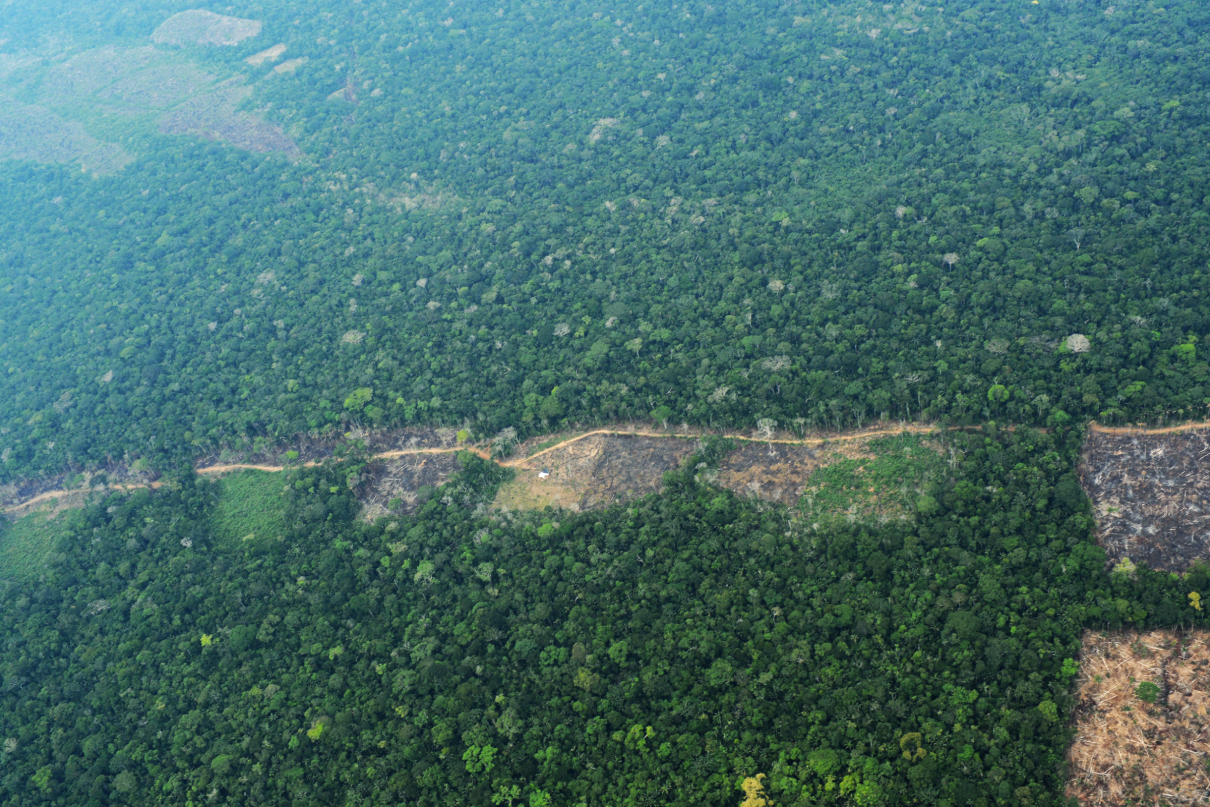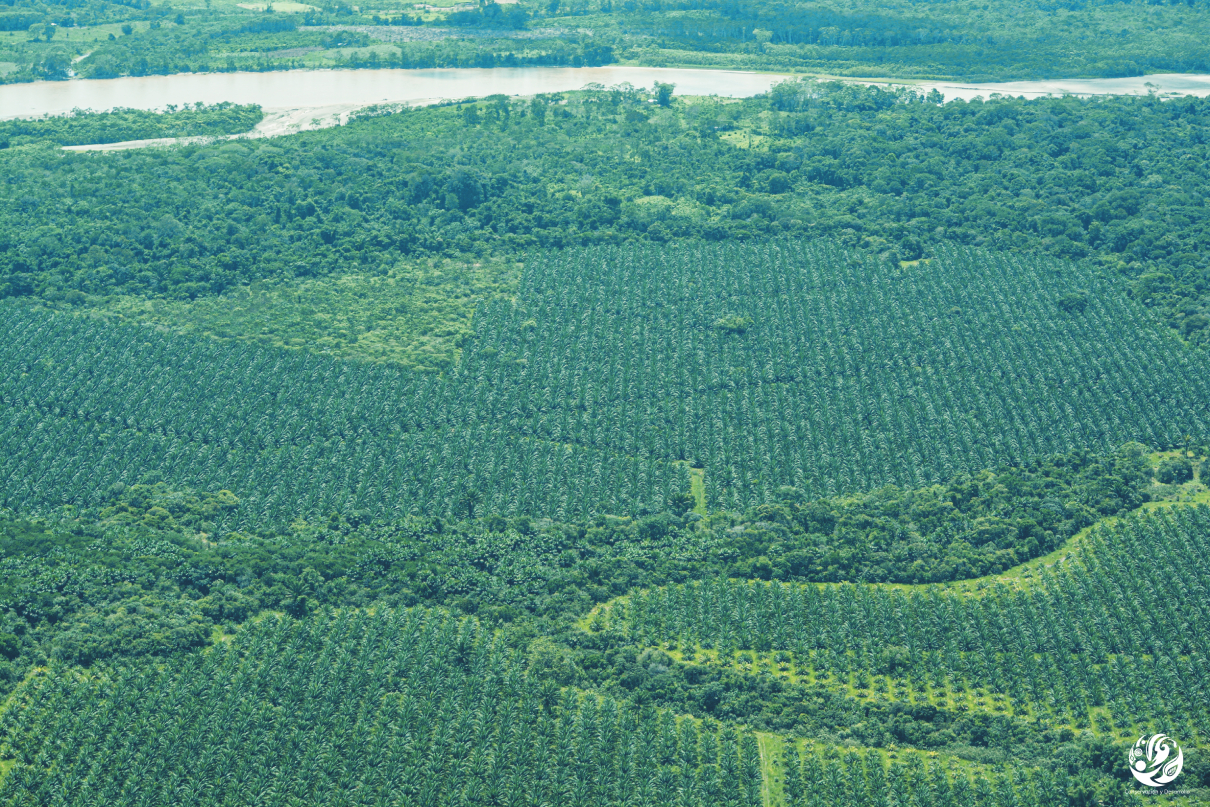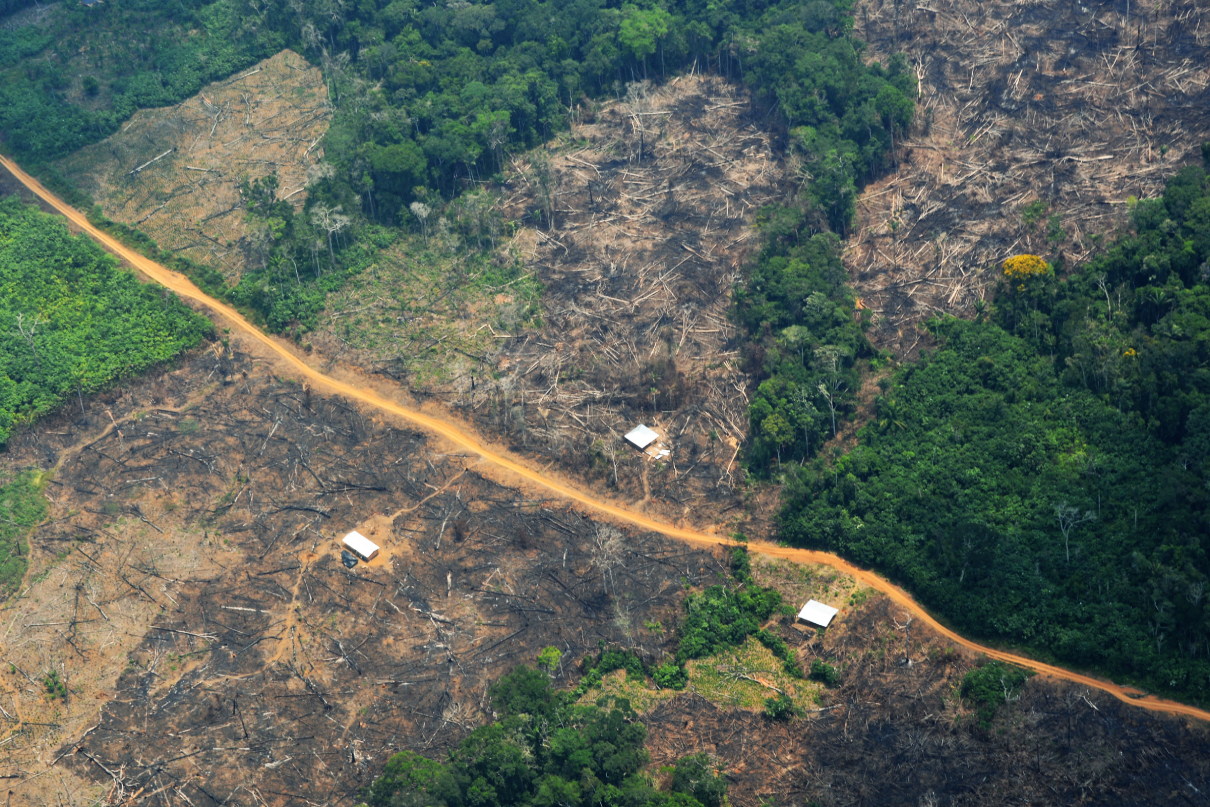- Staff from the National Nature Parks of Colombia (PNN) have been forced by former FARC rebels and other illegal armed groups to abandon 10 Amazonian parks that cover nearly 9 million hectares (22 million acres) and are home to an estimated 43,000 undiscovered species.
- The absence of PNN staff has negatively impacted surrounding campesino and Indigenous communities, as well as the monitoring of natural resources, threatened species, and climatic and hydrological information, which are all vital for decision-making and generating alerts.
- Indigenous communities in Colombia’s Amazon play a vital conservation role, but COVID-19 has been especially devastating to them.
- Infections have been reported among 33 of the region’s 60 Indigenous groups, 13 of which were already in danger of physical and/or cultural extermination.
In March 2020, as Bogota’s coronavirus quarantine began, a white smog hung over the city, coming from fires burning in Nukak National Nature Reserve, nearly 400 kilometers, or 250 miles, away.
Jenny Cueto is the head of the 855,000-hectare (2.1-million-acre) Nukak National Nature Reserve, which lies in Colombia’s Amazon and is home to one of the world’s last remaining nomadic tribes, the Nukak. In a telephone interview with Mongabay, Cueto said former members of the disbanded rebel group FARC had turned hostile toward the administrators of Colombia’s national parks and were now exploiting the areas.
“They started to encourage the growing of coca,” Cueto said. “Then they threatened us and said we couldn’t go back inside. They robbed us of our [work] items, a boat and a motor. From that moment we haven’t returned.”
FARC, or the Revolutionary Armed Forces of Colombia, signed a historic peace accord with the Colombian government in 2016 that also made a special inclusion for rural development and protecting natural areas. But the government hasn’t been able to occupy the vacuum left by FARC and the lucrative illegal economies it controlled, including growing coca, the raw ingredient for cocaine. These were taken over by other illegal groups, including former FARC rebels who refused to demobilize as part of the peace accord.
Colombia’s environment minister, Ricardo Lozano, says 70% of deforestation in the country stems from illegal activities, for which he blames the former FARC rebels and other illegal groups. Experts say fires are used to burn Amazonian forests to grow coca and also for cattle ranching, which is often used as a front for land grabbing.
During the first month of quarantine, the Amazonian Institute for Scientific Research (SINCHI) registered 12,958 heat points, indicating fires, in Colombia’s Amazonian departments, marking a 276% increase from the same time last year. Corpoamazonia, the government’s sustainable development corporation for the southern Amazon, says this points to how illegal groups are taking advantage of the quarantine to continue with their operations.
Cueto is a trained sociologist and has worked with Indigenous and campesino (peasant farmer) communities for more than 14 years in Nukak National Nature Reserve, part of the network of National Nature Parks of Colombia (PNN). Colombia’s first national park was established in 1960, in the midst of the country’s civil war. At the time it was decided to not arm PNN staff so as to maintain their neutrality in the conflict. Communication and engaging with communities are thus the most powerful weapons available to PNN staff. And so, in areas lacking meaningful government control, Cueto and her 11-person team, like other park rangers throughout Colombia’s Amazon, had grown accustomed to working with the presence of armed groups.
But in an unprecedented move, various armed groups have now threatened PNN staff, directly with weapons or by pamphleteering, and forced them as of February to abandon 10 Amazonian national parks, covering nearly 9 million hectares (22 million acres) and home to an estimated 43,000 undiscovered species.
Clara Solano, the director of Fundación Natura, which promotes Amazonian forest governance, working closely with PNN and other environmental organizations, said in a call with Mongabay that in her 25 years working in the region, she “can’t remember … even when the conflict was at its highest point between the state, the army and FARC, where we had a situation where armed groups explicitly threatened park rangers to leave protected areas.”
Mongabay approached PNN management for comment but was refused an interview.
“At the moment we are not giving statements on the subject because we are moving forward working on the subject with the relevant authorities,” said Ana Maria Rocha, PNN’s head of press and communications.

Amazon conservation by PNN and Indigenous communities
Almost all 48 million hectares (119 million acres) of Colombia’s Amazon, roughly the size of Spain, are protected. PNNs cover 12 million hectares (30 million acres) and Indigenous reserves make up approximately 26 million hectares (64 million acres). The region also boasts two UNESCO World Heritage sites; Colombia’s largest national park, Chiribiquete, which was one of those vacated by PNN staff; and the traditional knowledge of the jaguar shamans of Yuruparí.
Colombia’s 1991 Constitution is internationally regarded as a “green constitution” for its focus on environmental issues, including an emphasis on how a healthy environment is needed not only for the survival of human beings, but also for the survival of ethnic groups, and how protecting the environment and biodiversity is a relevant end in itself.
Colombia’s Constitutional Court has also found that ecosystems inhabited only by Indigenous groups maintain environmental conditions, and their presence and culture is an important part of conservation in these regions. In Colombia’s six Amazonian departments there are 185 Indigenous reserves and 60 Indigenous groups, each often representing a completely unique language and culture.
Indigenous communities, often working with PNN, play a vital conservation role, but COVID-19 has been especially devasting in communities sometimes numbering only a few hundred individuals and where each elder who dies represents the burning down of a library of traditional knowledge and culture.
The National Organization of the Colombian Amazon’s Indigenous Peoples (OPIAC) has criticized the government’s COVID-19 response in the region. The National Indigenous Organization of Colombia (Onic) presented a report to the José Francisco Cali, the United Nations Special Rapporteur on the Rights of Indigenous Peoples, noting that as of June 15, 906 positive cases of COVID-19 were reported in 33 Indigenous groups, of which 13 are in danger of physical and/or cultural extermination.

Impacts of national parks without rangers
Rodrigo Botero, director of the Foundation for Conservation and Sustainable Development (FCDS), explained in a video call with Mongabay the seriousness of the PNN evictions.
“Parks staff are sometimes the only state officials that you will find in certain places in the country,” Botero said. “In the Amazon they are critical for collecting information necessary to make urgent decisions, not only for protecting natural resources, but also for social conflicts or threats to ethnic or vulnerable groups.”
He added that PNN staff also develop processes to monitor natural resources, threatened species, and climatic and hydrological information, which are vital for decision-making and generating alerts.
According to Botero, the presence of PNN staff also guarantees several environmental protection projects, agreements and resources that get invested into local campesino and Indigenous communities.
Botero also says that PNN staff work as a bridge between local communities and the government at the municipal, departmental and national levels, for basic services including health and education. Botero says that PNN staff “understand that the well-being of communities is reflected in the protection or the depredation of natural resources.”

Protected areas as victims of the conflict
Harold Ospino, the Amazon regional coordinator for the Gaia Amazonas Foundation, has spent the last nearly 20 years working in Colombia’s Amazon, with a special focus on conservation agreements and resolving socioenvironmental conflicts. In a video interview with Mongabay, he discussed the chapter he contributed to the Spanish-language book Protected areas and their employees as victims of the conflict.
“[It’s] important to remember that most of the FARC surrendered and are adhering to the [peace] accord,” Ospino said. “But in a region like the Amazon, it isn’t necessary to have a big army so groups of eight or nine people that are armed, often including children, can go along a river, make threats and then disappear again. This way of acting makes it very difficult for government forces to stop them.”
The situation now is also more dangerous, according to Ospino, because with FARC there were clear command structures and one knew who they were dealing with. These smaller armed groups don’t have fixed structures and are more interconnected with narcotrafficking and other illegal operations.
Ospino says that in many areas of the Amazon a lack of governability creates a greater possibility for public officials to be victimized, not by illegal operations but also because political and state actors often see conservation as an obstacle to development, actively supporting activities like mining, oil extraction and road building. This can then create further divisions between PNN and local communities.
Eugenia Ponce de León, a renowned Colombian environmental lawyer, also contributed to the book. In a call with Mongabay, she explained that “an official who is there to defend a national park, to fulfill their duty to protect, to conserve … then also becomes a victim of the violent, criminal actions of these groups outside of the law, whether guerrillas or other criminal groups.”
The book provides detailed accounts of victimization which include direct harassment, kidnappings, robberies, the presence of anti-personal mines, the inability to express themselves or move freely, and even being scared to have their children stay with them in case they were forcibly recruited by criminal groups.
Since President Iván Duque took office in 2018, two park rangers having been murdered in Colombia, and Frontline Defenders reported Colombia as the most dangerous country in the world in 2020 to be an environmental defender.
Environmental defenders, including park rangers and Indigenous communities, could benefit from the implementation of the Escazú agreement, the first environmental human rights treaty for Latin America and the Caribbean.
Vanessa Torres, a lawyer and environmental researcher at the Association of Environment and Society, said in a call with Mongabay that the agreement is “fundamental in Colombia because there exists [a definition for] human rights defenders, community leaders, but environmental defenders have some specific characteristics, and Escazú supports this concept and furthermore it provides certain tools in how the government should protect them.”
Torres said the law was signed in December 2019, thanks in part to the environmental roundtable that emerged from national strikes late that year. The law was supposed to be ratified by Colombia’s Congress in March 2020 but was delayed because of the coronavirus.
“Global Witness has reported the strong connection between areas with high biodiversity and where there is armed conflict,” De León said, “and in the vast majority of the cases, these conflicts are connected to land; appropriating land and the natural resources of the areas.”

In 2018, Colombia’s Supreme Court made a landmark judgment declaring the Amazon subject to rights like a human being and requiring immediate action for its protection from the government. De León says that one of the recommendations from the book is to also take cases with PNN staff as victims to the Special Jurisdiction for Peace (JEP), a transitional justice mechanism that was a key part of the peace accord. This could provide the opportunity to measure the environmental cost of violence in the national parks.
Hector Velasquez, head of Cueva de Los Guácharos National Natural Park, Colombia’s very first national park, has worked for PNN for more than 25 years. He has kept a register for the last decade of movements of PNN staff, including threats and violence against them, and says PNN is preparing a submission to the JEP within the next year.

Western Amazon and the strong-armed government response
Colombia’s western Amazonian departments of Putumayo, Caquetá and Guaviare, where Nukak National Nature Reserve is located, used to be FARC strongholds during the country’s more than 50-year armed conflict. The area is home to the Colombian Amazon’s largest human populations, predominately of colonizers from other parts of the country. It is also the region most affected by deforestation, the growing of coca and threats from expanding roads and the oil industry, which create new towns and bring new waves of colonization.
PNN and Indigenous reserves also offer enticing places to grow coca as it is illegal in these protected areas to spray glyphosate, the herbicide used to kill coca crops. Cueto says Nukak National Nature Reserve is highly impacted by coca growing and that a large part of her work is to engage with campesinos who often moved from other parts of the country to find a piece of land or escape the country’s violence.

Before being forced to leave, Cueto’s team were making slow progress building confidence with these communities and negotiating for them to voluntarily stop growing coca and move outside the park to a special campesino reserve zone.
The current Colombian administration has been criticized for focusing too heavily on military operations to fight deforestation and enforce the eradication of coca plants, while not capturing those financing the deforestation. Instead it has gone after vulnerable campesinos and contributing to the long-term instability for the areas surrounding PNN areas.
These operations are often executed without consulting PNN staff. Cueto says that at Nukak “unfortunately a month after we went inside, the army came in to eradicate coca crops. In this zone all the campesinos have coca … a rumor went around that it was us [PNN] that informed on the locations, and this then reached the dissidents.”
FCDS director Botero says the government’s armed response can be useful and necessary, but at times it can be clumsy, and illegal armed groups like the dissidents can politically capitalize from these actions.
Military operations are expensive and unsustainable in the long term, and Botero says in these areas with very little state presence, if park rangers are to return to the national parks and their revictimization is prevented, the army needs to provide territorial control supporting the long-term presence of state services like health, agriculture and infrastructure.

Eastern Amazon and Indigenous groups
Colombia’s eastern Amazon was previously not as impacted by the armed conflict, and coca growing is not as big an issue in the region. Primarily made up of the departments of Amazonas, Guainía and Vaupes, these territories are almost completely covered by native forest and predominately inhabited by Indigenous communities.
Harold Rincón Ipuchima, from the Tikuna Indigenous community, a trained anthropologist and general secretary of OPIAC, explained the organization’s relationship to PNN in a video interview with Mongabay.
“Indigenous territories have … a role of ecological protection,” he said. “Parks also have this same mission and function … we put in place agreements for protection, monitoring of territories, and in some cases they are strong and result in inter-administrative agreements.”
In Yaigojé Apaporis National Natural Park on the border with Brazil, an Indigenous community pushed for the creation of a national park to help protect the area from a multinational mining company. And in Cahuinarí National Natural Park, PNN staff worked with communities to help save the world’s largest river turtle from extinction. Both Cahuinarí and Yaigojé Apaporis remain abandoned since FARC dissidents pushed out PNN staff.
Ipuchima says Indigenous communities face similar challenges as PNN staff in terms of illegal economies, especially illegal mining.
Mercury is used to extract gold, and illegal miners in the Amazon discard this toxic chemical directly into rivers, affecting both wildlife and people. PNN research showed extremely high levels of mercury in 66 Indigenous communities.
Based on this, in November 2019 OPIAC announced a humanitarian crisis in the Amazon, also ratifying a position to reject mining in the Amazon, both legal and illegal.
Although Indigenous reserves are generally autonomous and self-governing, several programs need technical and financial support from PNN. Additionally, large Indigenous community meetings and monitoring and control excursions require PNN to provide funds, fuel and resources..
“The best way to protect these territories and their biodiversity is through reinforcing and guaranteeing the cultural practices of the indigenous groups,” Ipuchima says.
Banner image: Military Operations can be useful and necessary against illegal armed groups, but they are also expensive and unsustainable in the long term. Image by Rodrigo Botero.
